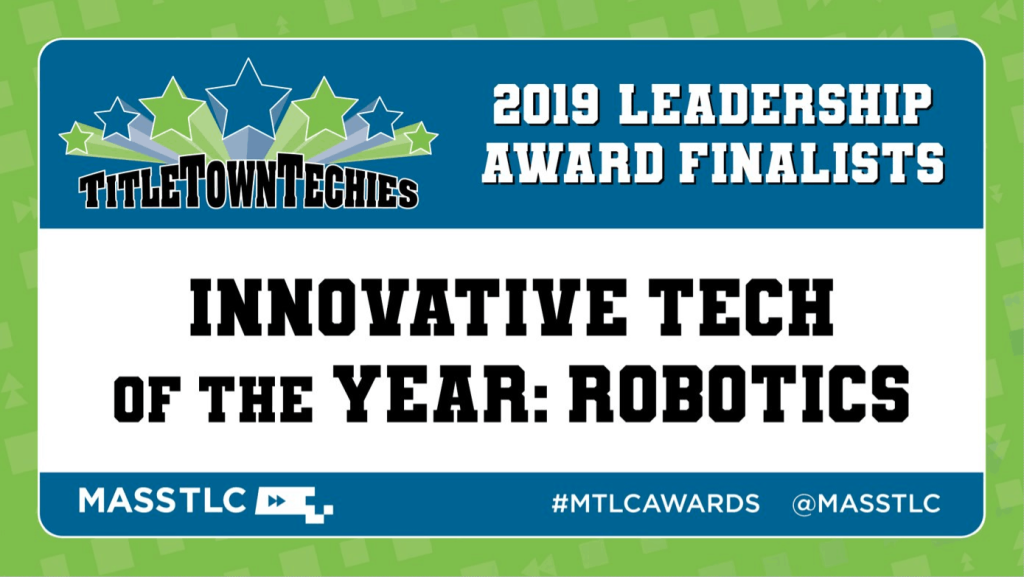For the past twenty-two years, the MassTLC Leadership Awards have celebrated the best and the brightest of the Massachusetts technology ecosystem. The sixteen award categories, including a newly added category for the Massachusetts Growth Company of the Year, highlight the vitality, innovation and importance of the region’s internationally respected technology industry. In addition, for the first time, MassTLC will honor the visionary organizations that are pioneering digital transformations to innovate and re-imagine the future of the Commonwealth’s leading industries in the form of the newly created Digital Transformation awards category.
The finalists in all sixteen categories were revealed during a reception at PTC’s Boston headquarters on September 10.
Winners will be announced at the All Stars of Tech Winners’ Celebration on November 6 at Fenway Park.
In the meantime, let us introduce you to the finalists and the incredible work that they are doing here in Massachusetts – and how they are changing the world.
In the words of their nominators, meet the 2019 “Innovative Tech of the Year in Robotics” finalists.
___
|
LinkedIn: https://www.linkedin.com/company/6-river-systems-inc. Twitter: @6riversystems What: The 6 River Systems (6RS) Mobile Sort Wall (“Mobile Sort”) enables warehouse operators to intelligently pick and sort batch totes to discrete orders using 6RS’ collaborative mobile robotic solution. Batching has long been used by each-picking operations to drive higher levels of productivity by consolidating and picking batches of items across discrete orders. The challenge has been managing the sortation of batches back to their discrete orders. Traditional automation (e.g. unit sorters) is expensive and complicated to run and manual sortation using put walls has been historically problematic, leading to a graveyard of unused automation in many of today’s warehouses. How Technology is Used: “Mobile Sort” consists of smart kiosks, put-to-light walls and validation sensors that work with 6RS’ cloud based software and 6RS robots, called “Chucks.” Associates are directed by Chucks to pick batches into totes, the Chucks then autonomously shuttle the totes to take-off locations where they are unloaded onto a mobile rack. The mobile racks are then paired with a mobile kiosk where an associate completes the sort of items into discrete cubbies, directed by product images, lights and proximity sensors to validate the task. Lightweight integration and a mobile design allows for a flexible and fast installation. The entire solution, from robot to sort station, is powered by 6RS’ machine learning and artificial intelligence. Why it Matters: 6 River Systems’ “Mobile Sort” is the first and only mobile consolidation solution using cloud software and mobile collaborative robots that works with any WMS to enhance productivity and throughput for high volume, seasonal, high SKU count, direct-to-consumer warehouses. “Mobile Sort” is a significant improvement over traditional put wall technologies that are expensive, require extensive WMS integration, are bolted to the ground and take months to deploy. Direct-to-consumer and each-picking operations are under pressure to pick faster and scale for peak with fewer seasonal hires. 6 River Systems’ “Mobile Sort” further advances its existing capabilities with a picking and sorting solution that is mobile and flexible, helping operators who are crunched for time, capital and resources balance performance and cycle times. |
|
LinkedIn: https://www.linkedin.com/company/dexai-robotics/ Twitter: @DexaiRobotics What: Dexai’s product, “Alfred”, automates food assembly by using utensils to scoop/pick ingredients, exceeding human capabilities in speed and precision. Alfred is a plug-and-play solution for existing restaurants, which allows them to automate food preparation without any alteration to their layout or recipes, while retaining recipe and process flexibility. How Technology is Used: Dexai automates activities in commercial kitchens and the food industry more broadly, using flexible robot arms. The company’s patented technology can be leveraged to automate other kitchen tasks such as cutting, dicing, as well as operating the fryer, grill, and other kitchen equipment. Why it Matters: Dexai’s products allows quick-service restaurants to scale their concepts and create new stores much faster. By using Dexai, restaurants are able to better predict food preparation costs while also lowering them substantially, which in turn allows them to lower prices. Dexai provides consistency to the food industry and eliminates health risks. Food prepared by Alfred, Dexai’s robot consistently features the same portions, taste the same, and free from contaminants. |

LinkedIn: https://www.linkedin.com/company/markforged/ Twitter: @markforged What: The Metal X is an end-to-end manufacturing solution with everything needed to go from design to fully functional metal parts and is the most affordable metal 3D print system available.Based on Markforged’s 4th generation composite 3D printing technology, the Metal X is a new kind of 3D printer. By printing metal powder bound in a plastic matrix, the company has eliminated the safety risks associated with traditional metal 3D printing while offering close to same-day print times, and 98 percent cost savings compared to traditional manufacturing processes. How Technology is Used: Prior to the Metal X, the story of metal 3D printing had been million-dollar machines that fill a room. Bulky, expensive, and unsafe for typical office environments, metal 3D printing was not something widely adopted for manufacturers, regardless of its impactful abilities.Markforged’s innovative technology has made metal 3D printing safe and accessible and is a process that’s compatible with 100s of metals, including 17-4 PH Stainless Steel, A2 Tool Steel and Inconel 625. This is a breakthrough technology that offers a new method of manufacturing low volume metal parts, which saves time and money for businesses across industries.The Markforged Metal X is the size of a household appliance and is “at home” in design offices, machine shops, or on factory floors in businesses all over the world. Why it Matters: Metal X is extremely affordable and easy to use compared to other machines that can cost well above millions of dollars and require complex installation. While enabling new features like closed-cell infill for reduced part weight and cost, the Metal X is up to 10x less expensive than alternative metal additive manufacturing technologies — and up to a 100x less than traditional fabrication technologies like machining or casting. The printer allows designers, engineers, and manufactures to design and print strong 3D metal parts overnight. This presents great value for businesses that want to print very complex parts that would otherwise cost thousands of dollars to traditionally manufacture, but cost a fraction of that to print. With the introduction of the Metal X, the 3D-printing process produces quality products at cheaper costs. |

LinkedIn: https://www.linkedin.com/company/realtimerobotics/ Twitter: @realtime_i What: Realtime Robotics gives automation teams the responsive motion planning solution they need to end the trade-offs between speed and safety. Traditional robot installations require significant investments in safety infrastructure, are unable to work in dynamic environments and require expensive programming for any single task. Cobots are safe enough to work in close proximity with people, but they cannot work fast, and they stop working when confronted by an obstacle. Realtime’s custom processor paired with state-of-the art sensors allow industrial robots to work safely near people. The powerful combination of advances in computing power and software make it possible for complex robots to adapt to dynamic, unstructured environments, as quickly as changes occur. How Technology is Used: Realtime Robotics/ software allows users to import models and carefully construct roadmaps that allow the robot to accomplish any desired task. The roadmaps are designed to deal with the robot and scene of interest. The software pre-computes the region of space that each motion collides with, so that at runtime Realtime’s MPA can quickly determine which motions are safe. Then, conventional graph search algorithms can be used to quickly find a path through the safe edges in the roadmap. Unlike train and repeat applications, this allows the use of robots in highly dynamic environments, since the hardware can support roadmaps of millions of motions. Unlike conventional planning algorithms, the collision checking is done ahead of time, to enable real-time speeds during execution. Why it Matters: Manufacturers recognize that more automation is an essential strategy for overcoming today’s business realities, including: rising labor costs and global labor shortages, increasingly sophisticated consumer demand and ongoing volatility in markets near and far. As a result, it’s estimated that robot adoption rates in manufacturing will increase 20 percent annually for the next five years (via RIA). This growth will be driven by robots that can apply logic, are ‘smart’ and can deal with quasi-structured and unstructured environments. Today’s robots are not safe or smart enough to navigate in dynamic, unstructured environments, without costly safeguards and oversight. Realtime Robotics’ solution eliminates a huge challenge on the evolutionary path for Robotics: responsive, fast motion planning. |

LinkedIn: https://www.linkedin.com/company/rewalk-robotics-inc- Twitter: @ReWalk_Robotics What: ReWalk Robotics’ technology is one of the soft wearable robotic systems to reach commercialization. The system is designed to provide assistance in regaining walking function post stroke. How Technology is Used: The technology is comprised of a soft, garment-like design which connects to a lightweight waist pack and mechanical cables that help lift the patient’s affected leg in synchronized timing with their natural walking pattern. The system provides targeted assistance to the patient during forward propulsion (plantarflexion) and ground clearance (dorsiflexion), two key phases of the gait cycle. The device also provides the physical therapists with extensive data during gait training with ReStore to help determine strategies to optimize a patient’s treatment and progress using real-time analytics. Why it Matters: Stroke is a leading cause of disability, which affects approximately 17 million people in the US and EU each year, and as many as 80% of people who have had a stroke will suffer from gait impairments. The clinical benefit being sought is improved walking symmetry, better walking speed and greater walking distances. ReWalk Robotics’ unique design will allow access to robotics technologies for stroke therapy to almost all active stroke clinics large and small. It moves this from being a limited niche market where only highly specialized centers can use and afford systems to a “main street” applicability because the versatility of the design reaches a much broader range of patients, and because it is a much more affordable design than the early generation rigid robotic designs. |





